Menus
- From the circuit to the road for the Italian sportswoman
- 4-stroke single cylinder, 340 cc, 42 hp, 210 km / h, 112 kg dry
- Discovery
- In the saddle
- Test
- Conclusion
From the circuit to the road for the Italian sportswoman
4-stroke single cylinder, 340 cc, 42 hp, 210 km / h, 112 kg dry
In 1954, the arrival of Fabio Taglioni revolutionized Ducati’s way of designing motorcycles, first by introducing its famous Desmodromic distribution, then by pushing the brand into competition to develop the basis of production motorcycles.. In 1967, the 350 SCD marks a further turning point since it is this which will allow the passage of the Desmo from the circuit to the road. Testing a truly historic motorcycle.
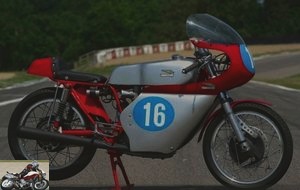 Ducati 350 SCD review
Ducati 350 SCD review
Discovery
More than any other manufacturer, Ducati has traditionally turned to racing in order to develop its range of road bikes and prove its worth. A policy which is illustrated by the serial successes over three decades of Superbikes from Bologna to V-Twins. But it all started over half a century ago. Because when the Italian company’s very first desmodromic road motorcycles were released in 1968, the 250, 350 and 450cc overhead camshaft single-cylinder range of two-valve single-cylinder engines turned out to be the direct progeny of racing motorcycles. factory. And for good reason, Ducati had entered them in the Italian and Spanish international events during the two previous seasons in the hands of Roberto Gallina, Gilberto Parlotti and Bruno Spaggiari, pillar of the factory team for more than a decade..
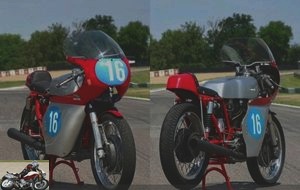 The Ducati 350 SCD
The Ducati 350 SCD
It is Roberto Gallina, who will be even better known later by becoming the manager of the Suzuki team, world champion in 500 GP. It was he who ensured the debut of the 350 prototype racing at Modena in March 1967. He finished there with a superb second place in the 350 race, immediately followed by seventh position in the 500 race on the same sub-bike. dimensioned. The machine was then largely based on the road 350 Sebring, taking up to the die-cast housings and the clutch of the latter. But it was fitted with a Desmo single-cam cylinder head similar to that used on a 250cc prototype which had only appeared once the year before in the hands of the pilot who became development engineer Franco Farnè. Using the same 76 x 75mm cylinder dimensions as the 340cc Sebring, the 350 prototype produced an impressive 41 horsepower for the era of 10,500 rpm.
Gallina and Parlotti continued to ride the pair of motorcycles that Ducati’s Reparto Sperimentale had built with consistently encouraging results in Italian races that year. The best performance will come in Sanremo at the end of the season when Gallina led the 500 race ahead of the three-cylinder MV Agusta and the four-cylinder Benelli before falling dramatically taking six drivers from the leading group with him after his tank burst. and flooded the track. I’m sure he was popular !
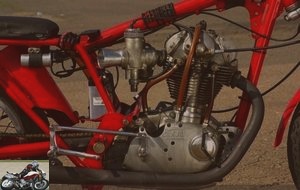 The 340cc single-cylinder engine is based in part on that of the Sebring
The 340cc single-cylinder engine is based in part on that of the Sebring
For the 1968 season the two 350cc prototypes were rebuilt and a third machine was made for Spaggiari. All models now feature sand-cast housings and a dry clutch, as well as revised camshafts that provide greater power distribution despite a massive 42mm Dell’Orto carburetor replacing the 38mm one. previously used, of a close ratio gearbox with straight cut primary gears and straight cut bevel gears on the vertical shaft driving the only overhead camshaft with both opening cams in the center and the two closing cams on the outside. Very light torsion springs are then installed to facilitate starting.
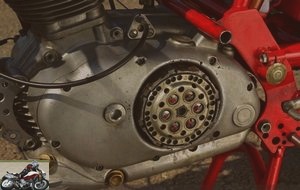 The dry clutch of the 350 SCD
The dry clutch of the 350 SCD
This layout, which became familiar to the generations of ducastiti that followed through its use on many road bikes like the Monsters, was at the time derived from the engineer’s desmodromic cylinder heads. Fabio Taglioni all of which used a triple camshaft format. By placing all the cams on the same shaft, Taglioni reduces their weight, friction, bulk, complications and expense. A step that the engineer had wanted to do for a long time:
I had designed such a cylinder head over ten years ago, but machining technology was not available until the mid-1960s to make such a design commercially feasible. Since at Ducati we only competed to develop new road models, I had to wait for the development of camshaft production techniques before I could produce a racing model to test the feasibility of my models. ideas on the track.
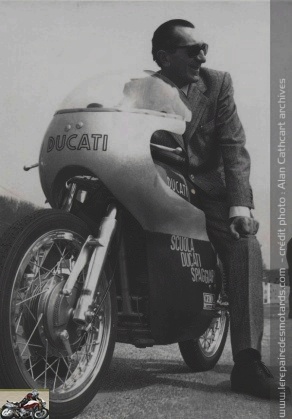 The 1968 season confirms the promise of the desmo single cylinder. Spaggiari then finished third in the 350 race in Alicante in January on his new bike behind Phil Read’s allegedly overloaded Yamaha 250 V4 and Giacomo Agostini’s triple MV..
The 1968 season confirms the promise of the desmo single cylinder. Spaggiari then finished third in the 350 race in Alicante in January on his new bike behind Phil Read’s allegedly overloaded Yamaha 250 V4 and Giacomo Agostini’s triple MV..
The stage was set for a result that would become familiar when the Continental Circus hit the road to Italy and during the Temporada di Primavera races that took place in the streets of the seaside resorts of the Adriatic coast, with a 450 version joining the 350 in first. Out of 350, Spaggiari thus finished third in Rimini, Cesenatico and Imola, second in Riccione and Vallelunga and each time first single cylinder behind the factory MV and Benelli..
From now on, the Ducati range of road bikes was launched, based directly on the sports factories with deliveries starting at the end of 1968. The Desmo mono were sold to Ducati distributors abroad and one of them is arrived in South Africa where Johann Boshoff won several successive 350 titles against the Yamaha two-stroke. Ultimately, the pace of development of the two-stroke will catch up with the Ducati, which then retired from racing in 1977 to be purchased by a collector in Johannesburg..
Seven years later I found him and bought him his machine to restore it for classic races in the UK.
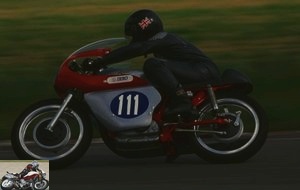 Alan on the Ducati 350 in 1988
Alan on the Ducati 350 in 1988
Steve Wynne, creator of Mike Hailwood’s Ducati 900, rebuilt the engine numbered SCD24 (Servizio Corse Ducati). It is overall in good condition and original, although a valve has obviously fallen inside the cylinder head. Wynne cleaned the ports and machined new valves by modifying some from his Pantah-based TT2 600. The valve timing on the factory camshaft was found to be very unusual for a Ducati single cylinder, but very similar to that of the later V-Twin 750 TT1 in terms of timing and lift. The 34 ° advance-operated ignition inherited two coils and a second 10mm spark plug to the right of the cylinder. This double ignition, used for the first time on a desmodromic mono, then became one of the favorite modifications of private Ducatis..
But before we got the bike rolling, we needed more info: how many revs to use, what ignition timing, etc. With rare factory machines like this, there is never an owner’s manual, although the Ducati closely resembled the road versions it then spawned..
 The SCD24 engine has undergone some modifications
The SCD24 engine has undergone some modifications
Fortunately, on my next visit to the Bolognese factory, Franco Farnè turned out to have an excellent memory, although all his notes, data and drawings of the single cylinders were destroyed in the disastrous 1969 factory fire.
We’ve only built half a dozen factory single-cylinder sports cars in all. Then we swapped the engines in the different frames: one week a frame would be driven with a 250 engine, the next week with the 350 and a different driver and so on. So you can’t really say that a motorcycle belonged to Spaggiari and another to Gallina. It was simply all the Meccanica Ducati factory racing bikes. We really used different combinations each time we ran. For example, your engine is the SCD24, which is one of the last we built, but the chassis appears to be a 1967 version which we later reinforced on the swingarm pivot and frame top tube by the head of the frame. direction. Every bike we went to the starting grid with back then was always a mix of parts. Granted, the engine had to conform to the latest specifications, with a Dell’Orto 42mm carburetor it delivered a peak power of 46hp at 9,500rpm, certainly not at 10,000rpm and above like on previous engines. These had a very short crankshaft life and persistent problems with broken rocker arms due to high revs. We have used many, many models of camshafts during this period. So I can’t tell what you have without seeing it, but if you don’t go above 9,500rpm you should have a fast and reliable machine..
 Franco Farnи was of good advice to adjust the bike
Franco Farnи was of good advice to adjust the bike
This is how it happened. I then had many successes with the desmo, in particular by winning the historic Italian GP of 350 cm3 on the complete circuit of Monza in 1988, 20 years after the birth of this bike. Later that same day I finished second in the 500 race behind a twin Linto, but ahead of all British single cylinders. In doing so I embarrassingly won a huge Il Trofeo Big Single cup which I use today as a bucket to chill the wine! There had been speculation before the race whether the Norton Manx or the Seeley G50 would win, but the fact that it was a small mono, an Italian on top, was not on the agenda..
Then we calculated that with these ratios the Ducati could reach 210 km / h unlike the 214 km / h claimed in the 1960s. The "missing" 4 km / h may have been due to my, uh, stature. less aerodynamic than Signor Spaggiari, but also the additional drag of modern tires. But despite everything, it still makes a good pace for a 4-stroke 350 cc single-cylinder..
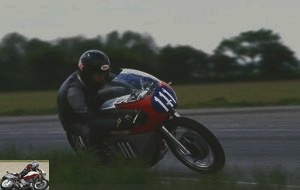 The 350 SCD managed to reach 210 km / h in 88
The 350 SCD managed to reach 210 km / h in 88
I finally sold my Ducati to a Spanish friend for a very good reason: to raise money to buy another, very different, which was to take the form of my first Ducati Supermono with which I had others. victories in the 1990s.
In the saddle
Much later, I was able to afford a trip down memory lane, thanks to my old friend and opponent Ian Griffiths, who had just rebuilt his own Ducati 350 that he offered me to drive on a sunny afternoon in summer at Mallory Park. Riding on that well-padded saddle was like donning an old pair of sneakers. Everything felt fair to me and I could even hide behind the big bubble in Mallory’s short straights..
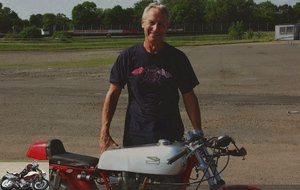 Ian Griffiths and his Ducati 350, very different in the fund
Ian Griffiths and his Ducati 350, very different in the fund
At first glance, Ian’s bike was a little different from the dozens of Ducati monos that have campaigned since the early 1970s in classic racing. This is not surprising, given that most of them sport various Vic Camp accessories like the fairing or the saddle taken from molds made on the original parts of this bike when it arrived in the UK from From the factory !
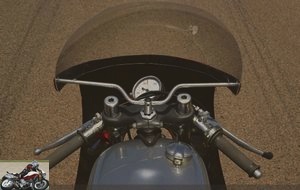 The ergonomics of the SCD are as welcoming as ever
The ergonomics of the SCD are as welcoming as ever
Once the fairing is removed, the proximity of the road model to the competition sports car becomes obvious / Only the dry clutch betrays its heritage. The front is similar to the mid-60s models that Taglioni took as a starting point. Even the frame is a modified production model, with the dropouts for hooking a center stand, but with braces under the long, thin fiberglass tank and a much longer than normal swingarm. The 1,385mm wheelbase is 60mm longer than on the equivalent road bike, putting more weight on the lean Dunlop KR825 front tire for increased grip while maximizing cornering speed, which is the right way to drive such a mono.
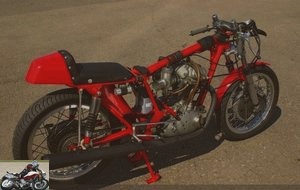 Under the fairing, there are many differences with the previous SCD
Under the fairing, there are many differences with the previous SCD
Test
The general feeling of the Ducati when you first sit on it is similar to that of an Aermacchi and at 112 kg it is about the same weight. No wonder the heavier Seeley 7R 350s couldn’t keep up with the Italian monos in these Adriatic road races as they returned 10 kg and 5 horsepower to the 42 hp at 10,250 rpm on the bike Ian is riding. today. But once in motion, the desmo engine looks much less like its rival Aermacchi, since the engine with its cylinder tilted slightly forward 15 ° seems much noisier. All these gears instead of humble pushrods contribute to a fairly high level of mechanical noise. There is also more vibration, which is transmitted well to the rider via the handlebars and footrests, but not too much to be annoying, at least for short runs..
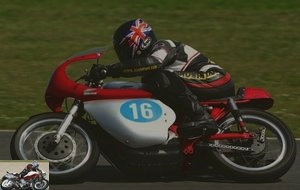 The single-cylinder is very noisy on the track
The single-cylinder is very noisy on the track
Although the engine is safely running above 10,000 rpm, there does not appear to be any additional horsepower available. This is only useful if one takes the suction of faster rivals (like the 500s) on a fast track like Monza or Assen, or to save some gear changes between two turns, such as coming out of the corner in Mallory hairpin to Bus Stop, which confirms Franco Farnè’s advice to limit the speed to 9,500 rpm. There’s not a lot of horsepower below 5,500 rpm, which not only makes final drive choice critical on every track, but once you get the hang of it, the engine pulls relentlessly. The 5-speed gearbox has perfectly calibrated ratios that keep the engine in the right range by tapping the selector with your right foot (in racing configuration) when the Veglia counter needle reaches 9,500 rpm. We must ignore the red line appearing 1,000 revs lower and we always find ourselves at the top of the power curve, while the megaphone escapement that Ian had installed for our test sings its wonderful high-pitched but warm sound. This motorcycle could only be Italian…
 The engine reaches 42 hp at 10,250 rpm
The engine reaches 42 hp at 10,250 rpm
Driving is agile, but inspires confidence. The fast steering isn’t as responsive as an Aermacchi, even on the narrow tire assortment Ian had opted for with a rear Avon AM22 matching the Dunlop up front. He had also set the Marzocchi fork very well, with no hint of dribbling over the bumps taken full angle in the fast Gerard curve taken in 4th and where the Ducati just shrugged maintaining good momentum for the exit of the turn..
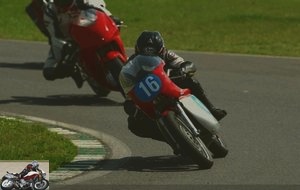 The cycle part is perfectly adjusted, agile without being nervous
The cycle part is perfectly adjusted, agile without being nervous
The small Oldani 210mm dual cam front drum brake works well initially, but just like the one on my bike did, it starts to fade a bit with repeated use, especially on braking all three corners. Slows from Mallory every 2km10. The slightly inefficient 200mm single-cam Oldani rear brake is fitted, with a hub machined by Ian after the original magnesium casting developed cracks that could not be welded. Still, the engine braking is better than I remembered. There is enough to make me take the lever back as the rear wheel slams a few times in the Edwina chicane when going back to second gear. On my own Desmo the engine brake was reduced so much that it was almost nonexistent and the flywheels appeared to be very small. This is probably the reason why it was difficult to start on the stroller starts, but also why I didn’t have as much low end torque as Ian’s bike. Let us not forget that, as confirmed by Franco Farnè, these motorcycles were all rolling test benches, testing different ideas that Taglioni invented and wanted to experiment on sports cars for possible use in his future road versions. It is therefore not surprising that our two motorcycles have different engine characteristics..
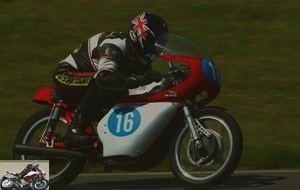 If the drums have limited efficiency, the engine brake here makes it possible to fill the gaps
If the drums have limited efficiency, the engine brake here makes it possible to fill the gaps
Conclusion
Ducati’s policy of using racing circuits to improve the desmodromic race and consistently producing the finest and most uncompromising Italian sports bikes started here, with this bike. Thanks to Ian Griffiths, the result can still be seen in action today, a true historic thoroughbred race against less authentic replicas. History on wheels…
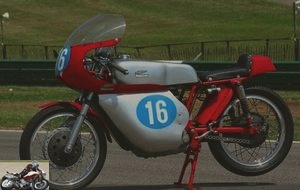 The Ducati 350 SCD remains a piece of motorcycle history
The Ducati 350 SCD remains a piece of motorcycle history
Strong points
- Agile and handy
- Motor
- Engine brake
- Driving position
Weak points
- Low revs
- Weak drums
The technical sheet of the Ducati 350 SCD
Related articles
-
Aprilia Tuono 1000 Factory Pikes Peak motorcycle test
Survive and win V4 at 65 ° of 1.078 cm3, 170 hp, 170 kg, victory and record at the Pikes Peak Motorcycle racing is inherently perilous, but there aren’t…
-
The best, quite simply 998 cc V4, 221 hp (234 hp) and 112 Nm, electronics and ride-by-wire, aerodynamic fairing, 193 kg full facts, 39,900 euros 2019…
-
Honda CB1100R T-Rex motorcycle test
The best Post-Classic sports car ever built 4 cylinders in line, 1,156 cm3, 145 hp, 160 kg, Harris frame, 273 km / h A T-Rex is big, strong, powerful ……
-
Laverda 915 SFC motorcycle test
Post-classic queen 915 cc parallel-twin, 90 hp, steel subframe, 167 kg It’s been 20 years since the last Laverda left the brand’s factories, but the…
-
Kawasaki Z1B Moriwaki motorcycle test
Wild and brilliant roadster 4 cylinders in line, 1,135 cm3, 119 hp, 160 kg It has been exactly 40 years since New Zealander Graeme Crosby entered the GP…
-
Kawasaki 1400 GTR motorcycle test
THE GT There always comes a time when every motorcyclist wonders about the positioning of his passion. And the current offer, with its various…
-
Homemade hotrod 649cc Triumph twin, Norton Manx clutch and fork, 48hp, 129kg dry Superbike racing and its Supersport derivative are largely responsible…
-
Sports test Ducati 750SS Moreparts
The Desmo of Mike Hailwood’s comeback 90 ° desmo V-Twin, 749 cm3, 73 hp, 180 kg dry Most road racing enthusiasts will tell you that Mike Hailwood did not…
-
Fine-tuning in order You don’t change a recipe that works. The second generation of the Ducati Diavel therefore evolves only on points of detail while…
-
Exclusive BMW K1600 GS Mammoth motorcycle test
Special K on two wheels 6 cylinders in line of 1,649 cm3, 160 hp, 175 Nm, 310 kg full made, 39 liter fuel tank, tubular frame, Dynamic ESA suspension……
try this morning at the Antony Honda dealership
then in strong point, a handling (at least a behavior in town and countryside) really top, big work on the suspensions, and it feels, the mix trail / roadster is really successful, opposite to the versys which him pulls towards the trail
instinctive driving position, the controls are ideal, the "scoot" handlebars are a little confusing but you get used to it after 2 min
45 minutes later .. the weak points, the counter, illegible (big sun today), it is written small, it is too high and we "seek" the information above
the engine … a little bland for a mid-size V4, it lacks peps at mid speed, it picks up well, like a VFR, it makes a nice noise, like a VFR, but it’s too sober in behavior. … like a VFR … on small country roads, far from binoculars and other radar boxes, it frees itself a little but still has to whip at 6000 laps to have the second kisscool effect (you will understand .. . the Vtec!)
Strictly speaking, a better gearbox would not have been a luxury, + short on the 2nd, 3rd or even 4th gear and things run out of steam on the last gear
except that braking at the top, normal … Honda, not really been able to test the dual ABS, we are only in concession testing
Review, very good bike the kind of motorcycle that I would like, only problem, displayed at more than 10,000 euros without options and excluding negotiation … the cbf 1000 even in S is 2000 euros cheaper!
the kind of motorcycle that I would like, only problem, displayed at more than 10,000 euros without options and excluding negotiation … the cbf 1000 even in S is 2000 euros cheaper!
Very nice this test! It’s true that when you see the weight all included, it makes you dream .
.
the carp> the mono Ducati (350 and especially 450) were far from being free from any reliability problem .
.
Happy owner of a VFR 800 X (that’s its code name) for 3 weeks … I can confirm that this is not a trail, nor a roadster, nor a GT … I think everyone suspected it … The perfect motorcycle does not yet exist … On the other hand, it is indeed a versatile motorcycle, reassuring, easy to use, intuitive .. After 1000 kms on its handlebars, 200 kms in duo, 2X2 lanes, country road, city … It suits me perfectly … But it is true that I am not too demanding. .. Young driver of 39 years old … I passed the course not long ago … Plateau with a CBF 600 and road with 600 Hornet … I find my new motorbike very endearing … I had made my weapons on a 125 Varadero (23000 kms) and I didn’t want to "fall back" into a 700 Transalpe … Very … Too consensual … The 1000 Varadero: too heavy and aging … The BMW GS 1200 .. . very expensive … even such an excellent bike … the GS 800: good bike … ore a little expensive in the end …. Well I’m finally a little too subjective on the subject … But a word of advice: try this bike … it’s worth the detour … And especially for the cool biker who seeks ease and security you will type in the 1000 … No sorry the 800 … LOL @ +
Electric, rather no ?